Nijmegen, Noviomagus
Q1309708Nijmegen: city in the Netherlands, where several Roman settlements have been discovered.
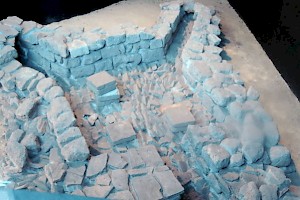
During the second century, Nijmegen was a flourishing town, called Ulpia Noviomagus. However, in the third century, pressure on the frontiers increased; new Germanic federations, like the Franks, tried to invade the Roman Empire. A capable commander named Postumus was able to reorganize the frontier zone, essentially founding a new, independent empire (the "Gallic Empire"): a sign of the self-confidence of the provincials north of the Alps.
Unfortunately, the "real" Roman Empire did not appreciate Gallic independence, and the emperor Aurelian eliminated the new state. Many troops were killed in the bloody battle of Châlons-sur-Marne, and the frontier was now unguarded. After 275, the Franks were free to invade, and for many years, they roamed through Gallia Belgica. Noviomagus was never rebuilt, and the area of the Lower Rhine was abandoned by the Empire until Constantius I Chlorus restored order.
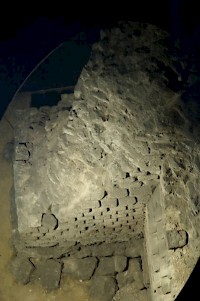
After 300, there were two settlements: a military one at the Valkhof, and a civil one along the river Waal. This was, essentially, the continuation of the river port that was already three centuries old and had served earlier settlements, like Batavodurum, the Hunerberg fortress, and Ulpia Noviomagus.
Archaeological research is very difficult, because a large part of the town along the river has been washed away - the Waal can be an unpredictable river, even today. However, when the modern casino was built, several remains of the ancient city came to light. One of these was a house with floor heating (hypocaustum) and a fresco, which cannot be dated exactly: it may go back to the second or third century, to an age at which Noviomagus was flourishing or in decline. The house may or may not have been in use in the fourth century. The remains are now visible at the front of the casino building, at a stone's throw from the river.
If you'd walk around the casino, you would see the remains of a heavy wall in a show case at the rear side of the building. About eighty meters of this wall have been excavated. It was apparently built in the fourth century and includes older structures. Another part of this large, heavy wall has been found near the old Besiendershuis.
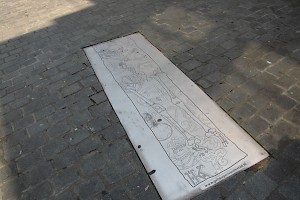
The cemeteries of Noviomagus have been identified to the southeast and southwest of the little town (the last-mentioned cemetery was discovered after the 1944 bombing of Nijmegen). They show that among the population were several surprisingly wealthy people. One of the most spectacular finds of the past decade was the "lady in lead", whose final resting place was discovered in the Burchtstraat in 2001. She must have been very rich, because her sarcophagus was made of lead, which must have been imported from Britain. Traces of gold prove that she once wore a dress of brocade. Analysis of her skeleton proves that she had very bad teeth, was between the thirty and fifty years old, and had been pregnant at least once.
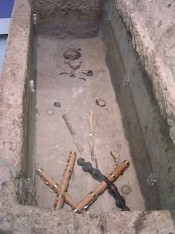
Another fascinating tomb contained the bones of a ten-year old girl. She must have belonged to a rich family, which could afford an expensive sarcophagus of natural stone. The little girl was buried with her tambourines, which has given this tomb the reputation of being the final resting place of a ballerina.
It is interesting to see that in the course of the fourth to sixth century, cremation becomes rare, while people are more often buried with their heads to the west, and with less and less funeral gifts. This has been taken as evidence for the Christianization, but is in fact no conclusive proof.
The town along the river and the castle on the Valkhof became Frankish in the first decade of the fifth century. To the inhabitants, this will not have made much difference, as many Franks had migrated to the south in the course of the fourth century, and had become romanized as much as the inhabitants of Noviomagus had become "Frankizised". The twin settlement had only some hundreds of inhabitants, but was sufficiently important to mint its own coins in the sixth century, with the legend Niomago.
Charlemagne and Frederick Barbarossa both built fortifications on the Valkhof, which, together with the settlement on the bank of the river, is the nucleus of modern Nijmegen.
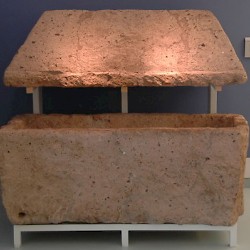 Nijmegen, Tomb of a girl of about ten years old |
 Nijmegen, Tambourine of a girl of about ten years old |
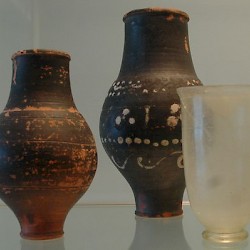 Nijmegen, Late Roman pottery |
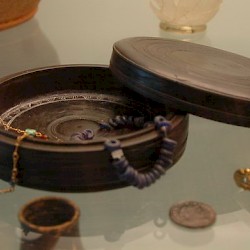 Nijmegen, Objects from the tomb of a fourth-century lady |